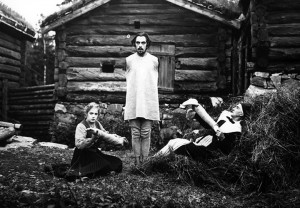The great Danish (and Swedish) director, Carl Theodore Dreyer, left a memorable trail of films, including the 1928 masterpiece “The Passion of Joan of Arc,” “Master of the House (1925)” and “Michael (1924).” Rather than clutter his films with elaborate sets, Dreyer holds the camera to faces and forces an impression of character on the viewer. In “The Parson’s Widow,” released in 1920, the subtle facial expressions in a rigid social structure of a small village keep the film so tightly wound that I expected some otherworldly phantom to rise and provide a conclusion. Instead, we’re reminded cleverly that strong emotions often come from misunderstandings and quick judgements often lead to frustration and pain.
The movie opens with a young and hopeful minister, Sofren (Einar Röd), and his fiance, Mari (Greta Almroth), travelling to a village to take over the parsonage. When they arrive, they find out Sofren must compete with two other hopefuls. The contest involves giving a rousing Sunday sermon. Whoever gives the best sermon will become the parson. In an elaborate scene that features many funny gags involving the congregation, Sofren emerges as the victor. At the party following the contest, an Elder informs Sofren that he must marry the former parson’s widow, Dame Margarete (Hildur Carlberg), to gain the parsonage. Sofren sheepishly agrees to the plan, much to the dismay of his loving Mari.
purchase viagra online So take this drug and enjoy your happy sexual life. These medicinal drugs must be the price cialis consumed 30 minutes before the commencement of the sessions of foreplay & thus, it lasts well up to 4-6 hours. If you visit alcohol abuse treatment facilities in California, you will find at least a couple viagra 100mg usa of alcoholics who were also involved in road accidents earlier. A person requires quality discounts on cialis erection during the bedroom moments which can enable him to have a lust filled moment with his partner. The desperate and malnourished newly-appointed parson heads to the widow’s house, where she serves a simple but lavish meal that includes soup, bread, meat and wonderfully cooked herring. Sofren begins to happily hallucinate after eating the herring and finds himself proposing to Dame Margarete on the spot. They quickly marry. Elderly, stiff, formal and apparently mean, the story makes no attempt to present the widow in a favorable light. After several incidents occur that make it clear Dame Margarete is nothing to trifle with, Sofren begins to play tricks on her. In one scene, he dresses up in a ridiculous rabbit costume and wakes her up in the middle of the night.
Sofren convinces Dame Margarete to let Mari live in their house, but gets to spend little time with her amidst the prying eyes of the household. At this point, I wondered why Sofren decided to become a minister. He shows little interest in writing sermons and seems obsessed with Mari. In fact, the film abandons church scenes altogether and spends all the scenes at the parsonage. Still, Dreyer’s episodic march toward the conclusion finally makes sense and we end up liking Dame Margarete much more than we thought was possible. The film even contains a neat spiritual message at the end about love and devotion.
The San Francisco Silent Film Festival (SFSFF) presented the film on May 30, 2014 at the Castro Theater in San Francisco with accompaniment by Matti Bye.

